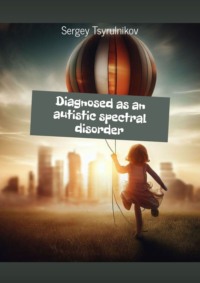Czytaj książkę: «Diagnosed as an autistic spectral disorder»
Child who was diagnosed as an autistic spectral disorder.
“The autism universe is a journey where every star is different and every brilliance is important. Your care and understanding are the keys to your child’s development and happiness. Let us together form a world where love and patience will create the basis for each next step in the stages of development.”
© Sergey Tsyrulnikov, 2024
ISBN 978-5-0060-0384-2
Created with Ridero smart publishing system
CHAPTER 1: UNDERSTANDING AUTISM SPECTRUM DISORDERS
1.1. WHAT IS ASD?
Autism spectrum disorder (ASD) is a complex disorder of the nervous system that affects a person’s ability to communicate, socialize, and interact with the world around them. It is important to note that ASD is a broad spectrum, manifesting itself in each individual in a unique way, with varying degrees of severity. Children with ASD usually show signs of this disorder in early childhood. In most children with autism spectrum disorders, the first manifestations become noticeable before the age of three. These signs include difficulty in social interaction, difficulty making eye contact, using gestures, and understanding social cues. In addition, children with ASD may exhibit repetitive behaviors, not tremble, have limited interests, and have difficulty adapting to change.
1.2. TYPES OF ASD AND HOW THEY ARE DIAGNOSED
Currently, ASD is considered as a single unit and not as a set of individual disorders. This change came after the diagnosis of Asperger’s syndrome and other related conditions were lumped together under the umbrella name of autism spectrum disorder in May 2013.
So, instead of being divided into different types, ASD is now seen as a spectrum in which each person has a unique set of characteristics and severity of symptoms. This allows for a more accurate approach to the diagnosis and support of each individual, taking into account his individual characteristics and needs.
Some people with ASD may also have other medical conditions, such as mental retardation, epilepsy, or ADHD (attention deficit hyperactivity disorder). It is possible that people with ASD can be highly functioning, they can live independently, get an education and successfully adapt to society. Sometimes people with ASD have particularly gifted individuals who show exceptional abilities in certain areas.
The diagnosis of ASD is based on a careful assessment carried out by a team of specialists, including a pediatrician, neurologist, psychologist and speech pathologist. The assessment process includes a medical examination to rule out other possible symptoms, behavioral observations, interviews with parents, and an assessment of the child’s language, communication, and cognitive skills. A more complex assessment is required when ASD is suspected.
1.3. CAUSES AND RISK FACTORS OF ASD
The exact causes of ASD are not yet fully understood, but researchers believe that a combination of genetic and environmental factors may contribute to the development of the disorder. Some of the known risk factors for ASD include: Genetic factors: ASD tends to run in families, and certain genetic mutations can increase the risk of developing the disorder. Environmental factors: Exposure to certain toxins or chemicals during pregnancy, complications during pregnancy or childbirth, and intrauterine infections can increase the risk of ASD. Brain development: Abnormalities in brain development or function may play a role in the development of ASD. Although the causes of ASD are not fully understood, researchers continue to study the disorder in hopes of improving our understanding of its origins and finding more effective treatments.
CHAPTER 2. EARLY SIGNS AND ASD SCREENING TEST
Early identification and intervention for autism spectrum disorder (ASD) is critical to improving rehabilitation outcomes for children with the disorder. In this chapter, we will discuss the following:
2.1. THE IMPORTANCE OF EARLY DETECTION AND INTERVENTION
The ASD diagnostic process usually involves a comprehensive evaluation by a team of professionals, including a pediatrician, psychologist, and speech therapist. Research confirms that early detection, through the M-CHAT SCREENING TEST, and intervention can help improve outcomes in children with ASD by providing them with the support and resources they need to develop the language, cognitive, communication, social, and behavioral skills that will help them succeed in school and in life. Overall, early detection and intervention play a critical role in creating a supportive environment for the development of children with ASD.
Some commonly used screening tools include the Modified Toddler Autism Checklist (M-CHAT), the Autism Diagnostic Observation Schedule (ADOS), and the Social Communication Questionnaire (SCQ).
These tools can help identify children who may be at risk of developing ASD and can help guide the diagnosis process. Early screening and intervention can help ensure that children with ASD receive the support and resources they need to thrive. The lack of this support can affect their overall quality of life, educational achievement, and social adjustment.
Darmowy fragment się skończył.
